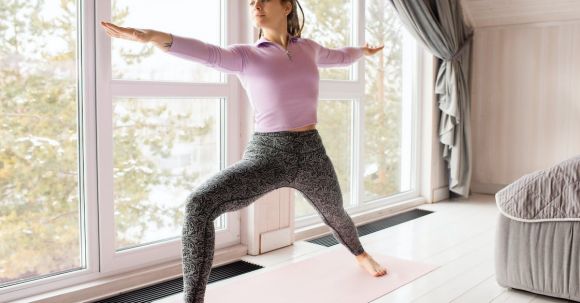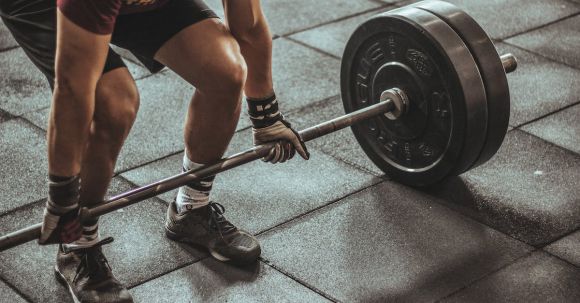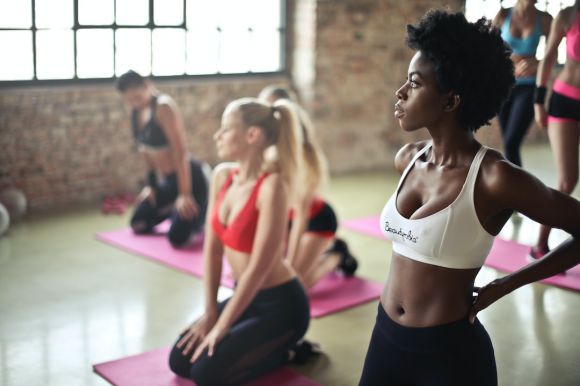Maintaining good posture is crucial for overall health and well-being. However, with our modern sedentary lifestyle, many of us find ourselves slouching and hunching over desks and screens for hours on end. This not only affects our physical appearance but also leads to various health problems such as back pain, neck tension, and even poor digestion. The good news is that you can improve your posture by incorporating a few simple home exercises into your daily routine. In this article, we will explore some effective exercises that can help you achieve better posture and alleviate discomfort.
Blog Posts
In today's fast-paced world, finding time to hit the gym can be a challenge. However, that doesn't mean you have to sacrifice your fitness goals. With the right home workouts, you can build lean muscles without ever leaving the comfort of your own home. In this article, we will explore effective strategies and exercises that will help you achieve your desired results.
Create a Dedicated Workout Space
Before diving into the exercises, it's important to set up a dedicated workout space in your home. This could be a spare room, a corner of your living room, or even your backyard. Having a designated area will help you stay focused and motivated during your workouts.Bodyweight Exercises
Bodyweight exercises are a fantastic way to build lean muscles without any equipment. These exercises use your own body weight as resistance, targeting multiple muscle groups at once. Some effective bodyweight exercises include push-ups, squats, lunges, planks, and burpees. Aim to perform three sets of each exercise, with 10-15 repetitions per set.Resistance Bands
Resistance bands are a versatile and affordable tool that can help you enhance your home workouts. They come in various levels of resistance, allowing you to gradually increase the challenge as you get stronger. Incorporate exercises such as bicep curls, tricep extensions, lateral raises, and rows into your routine. Aim for three sets of each exercise, with 10-12 repetitions per set.Dumbbells
Dumbbells are another excellent option for building lean muscles at home. They can be easily stored and provide a wide range of exercises to target different muscle groups. Start with a pair of dumbbells that are challenging but manageable. Exercises such as dumbbell bench press, shoulder press, lunges with dumbbells, and bent-over rows can help you sculpt your muscles. Aim for three sets of each exercise, with 8-10 repetitions per set.HIIT Workouts
High-Intensity Interval Training (HIIT) is a popular form of exercise that combines short bursts of intense activity with brief recovery periods. HIIT workouts are highly effective for burning fat and building lean muscles. You can incorporate bodyweight exercises, resistance bands, or dumbbells into your HIIT routine. Perform each exercise for 30-45 seconds, followed by 15-20 seconds of rest. Repeat the circuit for a total of 3-4 rounds.Stay Consistent and Progress
Consistency is key when it comes to building lean muscles at home. Aim to work out at least three times a week, gradually increasing the intensity and duration of your workouts as you progress. Challenge yourself by increasing the resistance, adding more repetitions, or trying more advanced variations of the exercises.Stay Hydrated and Eat a Balanced Diet
To support your muscle-building goals, it's important to stay hydrated and fuel your body with a balanced diet. Drink plenty of water throughout the day and consume foods rich in protein, such as lean meats, fish, eggs, beans, and lentils. Additionally, include a variety of fruits, vegetables, whole grains, and healthy fats in your diet to provide your body with essential nutrients. In conclusion, building lean muscles at home is achievable with the right exercises and dedication. Set up a dedicated workout space, incorporate bodyweight exercises, resistance bands, or dumbbells into your routine, and consider adding HIIT workouts for maximum results. Stay consistent, progress gradually, and fuel your body with a balanced diet. With these strategies in place, you'll be well on your way to achieving your fitness goals from the comfort of your own home.
Pregnancy is a beautiful and transformative time in a woman's life. However, it can also bring about physical changes that may make exercise seem challenging. It is important for pregnant women to maintain their fitness and overall health during this period. Similarly, postpartum recovery requires special attention to rebuilding strength and stamina. Engaging in cardio exercises can be an effective way to achieve these goals. In this article, we will explore the benefits of cardio exercises for pregnant women and postpartum recovery.
Benefits of Cardio Exercises during Pregnancy
1. Increased Energy Levels: Pregnancy can often leave women feeling tired and fatigued. Engaging in regular cardio exercises can help boost energy levels by improving blood circulation and enhancing oxygen flow to the muscles. 2. Improved Cardiovascular Health: Cardio exercises such as brisk walking, swimming, and stationary cycling can improve heart health, leading to better overall cardiovascular fitness. This is especially important during pregnancy, as the heart has to work harder to support both the mother and the growing fetus. 3. Weight Management: Pregnancy is a time when weight gain is expected. However, excessive weight gain can lead to complications for both the mother and the baby. Cardio exercises can help manage weight gain by burning calories and maintaining a healthy body mass index (BMI). 4. Reduced Risk of Gestational Diabetes: Gestational diabetes is a condition that affects pregnant women and can have long-term health implications. Engaging in cardio exercises can help regulate blood sugar levels, reducing the risk of developing gestational diabetes. 5. Improved Mood and Reduced Stress: Pregnancy can bring about hormonal changes that may lead to mood swings and increased stress levels. Cardio exercises release endorphins, also known as the "feel-good" hormones, which can help reduce stress and improve overall mood.Cardio Exercises for Pregnant Women
1. Walking: Walking is a low-impact exercise that can be easily incorporated into any daily routine. It helps improve cardiovascular fitness without putting excessive strain on the joints. 2. Swimming: Swimming is a great cardio exercise for pregnant women as it provides a full-body workout while minimizing impact on the joints. Additionally, the buoyancy of water can help relieve the weight and pressure on the growing belly. 3. Stationary Cycling: Cycling on a stationary bike is a safe and effective way to get the heart pumping without putting stress on the knees and ankles. Adjusting the resistance and speed can provide a customized workout based on individual fitness levels.Cardio Exercises for Postpartum Recovery
1. Pelvic Floor Exercises: Pelvic floor exercises, also known as Kegels, help strengthen the muscles that support the bladder, uterus, and bowels. These exercises can be done anywhere and at any time, making them ideal for postpartum recovery. 2. Low-Impact Aerobics: Low-impact aerobics classes specifically designed for postpartum women can help rebuild cardiovascular fitness and muscle tone. These classes usually incorporate gentle movements that are safe for the healing body. 3. Dancing: Dancing is not only a fun way to burn calories but also a great cardio exercise for postpartum recovery. It helps improve coordination, flexibility, and stamina while providing an emotional boost. In conclusion, engaging in cardio exercises during pregnancy and postpartum recovery can offer numerous benefits for both the mother and the baby. From increased energy levels to improved cardiovascular health, these exercises play a crucial role in maintaining overall fitness and well-being. Remember to consult with a healthcare professional before starting any exercise routine during pregnancy or postpartum. Listen to your body and make modifications as needed. Stay active and enjoy the journey of motherhood!
In today's fast-paced world, finding balance and harmony between our mind and body has become increasingly important. Yoga and meditation have emerged as powerful tools to help us achieve this connection. By combining physical postures, breathwork, and mindfulness, these practices can have profound effects on our mental, emotional, and physical well-being. In this article, we will explore how yoga and meditation can strengthen the mind-body connection and provide practical tips for incorporating these practices into your daily routine.
The Power of Yoga
Yoga, an ancient practice originating from India, has gained immense popularity worldwide due to its numerous benefits. One of the key aspects of yoga is the focus on synchronizing the breath with movement. This mindful breathing creates a sense of awareness and presence in the present moment, allowing us to connect deeply with our physical body. Through regular practice, yoga can improve flexibility, strength, and balance. However, its benefits extend far beyond the physical realm. Yoga also cultivates mental clarity, emotional stability, and stress reduction. By consciously moving through each pose and observing the sensations in our body, we become more attuned to our physical and mental state. This increased self-awareness helps us identify and release tension, promoting a greater sense of relaxation and overall well-being.The Art of Meditation
Meditation, on the other hand, focuses on training the mind to achieve a state of calm and inner peace. By practicing mindfulness and concentration, we learn to observe our thoughts and emotions without judgment. This allows us to develop a deeper understanding of ourselves and the world around us. Regular meditation has been shown to reduce stress, anxiety, and depression. It enhances self-awareness, improves focus and concentration, and promotes emotional resilience. By dedicating a few minutes each day to stillness and silence, we can cultivate a sense of inner calm that extends into our daily lives.Integrating Yoga and Meditation into Your Routine
Now that we understand the benefits of yoga and meditation, let's explore some practical ways to incorporate these practices into our daily routine: 1. Start with a short meditation: Begin your day with a few minutes of meditation to set a positive tone for the rest of the day. Sit in a comfortable position, close your eyes, and focus on your breath. Notice the sensation of the breath entering and leaving your body, allowing any thoughts or distractions to come and go without attachment. 2. Practice mindful movement: Incorporate yoga into your daily routine by dedicating a specific time for practice. Choose a style and duration that suits your needs and abilities. As you move through each pose, pay attention to the sensations in your body, the rhythm of your breath, and the thoughts that arise. Allow yourself to fully immerse in the present moment. 3. Take mindful breaks: Throughout the day, take short breaks to reconnect with your body and mind. Stand up, stretch, and take a few deep breaths. Close your eyes for a moment and bring your attention inward. Notice any areas of tension or discomfort and consciously release them. 4. Cultivate gratitude: At the end of each day, take a few moments to reflect on the things you are grateful for. This simple practice can shift your focus from what went wrong to what went right, promoting a positive mindset and a sense of contentment. In conclusion, yoga and meditation offer powerful tools for strengthening the mind-body connection. By incorporating these practices into our daily routine, we can cultivate self-awareness, reduce stress, and improve our overall well-being. Start small and gradually increase the duration and intensity of your practice. Remember, it's not about achieving perfection but rather embracing the journey of self-discovery and growth.
Warming up is an essential aspect of any workout routine, especially when it comes to cardiovascular exercises. Many people often overlook the importance of warming up and jump right into their workout, neglecting the potential risks and benefits that a proper warm-up can provide. In this article, we will explore why warming up before cardiovascular exercises is crucial for maximizing performance and minimizing the risk of injury.
Enhanced Blood Flow and Oxygen Delivery
One of the primary benefits of warming up is that it increases blood flow and oxygen delivery to the muscles. When you engage in cardiovascular exercises, your heart rate and breathing rate increase to meet the demand for oxygen. By warming up beforehand, you gradually raise your heart rate and dilate your blood vessels, allowing for a smoother transition into the intense workout. This enhanced blood flow and oxygen delivery prepare your muscles for the upcoming exertion, reducing the likelihood of muscle cramps and fatigue.Improved Muscle Flexibility and Joint Range of Motion
Another advantage of warming up is that it improves muscle flexibility and joint range of motion. During a warm-up, you engage in dynamic stretching exercises that target the muscles you will be using during your cardiovascular workout. These stretches help to lengthen and loosen the muscles, making them more elastic and less prone to strains or tears. Additionally, warming up allows the joints to lubricate, reducing friction and enhancing their range of motion. This increased flexibility and joint mobility enable you to perform cardiovascular exercises with proper form and technique, minimizing the risk of injury.Mental Preparation and Focus
Warming up is not just about physical preparation; it also plays a significant role in mental preparation and focus. As you ease into your warm-up routine, your mind begins to shift from the distractions of the day to the task at hand. This mental transition allows you to focus on your cardiovascular workout, increasing your concentration and motivation. By taking a few minutes to warm up, you can enter the exercise session with a clear mind and positive mindset, leading to a more productive and enjoyable workout.Injury Prevention
Perhaps the most crucial reason for warming up before cardiovascular exercises is injury prevention. By gradually increasing your heart rate, blood flow, and muscle temperature, you prepare your body for the physical stress it will experience during the workout. This gradual warm-up reduces the risk of muscle strains, sprains, and other common exercise-related injuries. It also gives you an opportunity to assess your body's readiness for the workout, allowing you to make any necessary adjustments or modifications to prevent potential injuries.Conclusion: Make Warming Up a Priority in Your Workout Routine
In conclusion, warming up before cardiovascular exercises is vital for maximizing performance and minimizing the risk of injury. The benefits of warming up include enhanced blood flow and oxygen delivery, improved muscle flexibility and joint range of motion, mental preparation and focus, and injury prevention. By incorporating a proper warm-up routine into your workout regimen, you can ensure that you are adequately prepared for the demands of your cardiovascular exercises. So, make warming up a priority and reap the rewards of a safe and effective workout.
When it comes to building strength and power, your legs are the foundation. Whether you're an athlete looking to improve performance or simply someone who wants to feel stronger and more confident, focusing on leg exercises is key. In this article, we will explore some of the most effective exercises for building stronger legs.
Squats: The King of Leg Exercises
No leg workout is complete without squats. This compound exercise targets multiple muscles in your legs, including the quadriceps, hamstrings, and glutes. To perform a squat, stand with your feet shoulder-width apart, lower your body as if you're sitting back into a chair, and then push through your heels to return to the starting position. To add intensity, you can hold a dumbbell or a barbell across your shoulders.Lunges: Strengthening One Leg at a Time
Lunges are another fantastic exercise for building leg strength. They work your quadriceps, hamstrings, glutes, and calves. To do a lunge, take a step forward with one foot, lower your body until your front thigh is parallel to the ground, and then push back up to the starting position. Repeat on the other leg. You can make lunges more challenging by holding dumbbells in your hands or by stepping onto an elevated platform.Deadlifts: A Powerful Leg and Back Exercise
Deadlifts are often thought of as a back exercise, but they also engage your legs, particularly your hamstrings and glutes. To perform a deadlift, stand with your feet hip-width apart, bend your knees, and lower your hands to grip a barbell on the floor. Keeping your back straight, lift the barbell by straightening your legs and driving your hips forward. Lower the barbell back to the floor with control. Deadlifts can be done with a barbell, dumbbells, or even kettlebells.Calf Raises: Building Strong and Defined Calves
Calf raises are a great exercise for targeting your calf muscles. To do a calf raise, stand on the edge of a step or a raised platform with the balls of your feet, and then raise your heels as high as possible. Hold for a moment at the top, and then lower your heels below the step. You can do calf raises with both feet at the same time or focus on one leg at a time for an extra challenge. To add resistance, hold dumbbells in your hands.Step-Ups: Functional Leg Strength
Step-ups are a functional exercise that mimics movements you do in everyday life, such as climbing stairs. They primarily target your quadriceps, but also engage your glutes and hamstrings. To perform a step-up, place one foot on a sturdy platform, and then step up onto it, driving through your heel. Step back down and repeat on the other leg. You can increase the intensity by holding dumbbells or adding height to the platform. Incorporating these exercises into your leg training routine will help you build stronger and more powerful legs. Remember to start with a weight or resistance that challenges you but allows you to maintain proper form. As you get stronger, gradually increase the weight or resistance to continue progressing. With consistency and dedication, you will see improvements in your leg strength and overall fitness. So, get ready to build those strong legs and unleash your full potential!
In today's busy world, finding time to hit the gym or attend fitness classes can be a challenge. However, it is important to prioritize our health and fitness, especially when it comes to strengthening our muscles. Building muscle not only improves our physical appearance but also enhances our overall strength and functionality. The good news is that you don't need fancy equipment or a gym membership to achieve this. With a little creativity and dedication, you can strengthen your muscles from the comfort of your own home.
Bodyweight Exercises: The Foundation of Strength
When it comes to building muscle at home, bodyweight exercises are your best friend. They require no equipment and can be done anywhere, making them the perfect choice for home workouts. Bodyweight exercises such as push-ups, squats, lunges, and planks target multiple muscle groups at once, providing a full-body workout. By incorporating these exercises into your routine and gradually increasing the intensity, you can effectively build strength and muscle mass.Resistance Bands: A Portable Gym
Resistance bands are a versatile and affordable tool that can take your home workouts to the next level. They come in various strengths and can be used to target specific muscle groups. Whether you want to work on your upper body, lower body, or core, resistance bands can provide the necessary resistance to challenge your muscles. From bicep curls and tricep extensions to squats and glute bridges, the possibilities are endless. Best of all, resistance bands are lightweight and portable, making them a great option for those who travel frequently.Dumbbells: The Classic Strength Builder
If you're looking to invest in some equipment for your home workouts, dumbbells are a great choice. They are versatile, allowing you to target different muscle groups and adjust the weight according to your fitness level. Dumbbell exercises such as shoulder presses, chest presses, rows, and lunges engage multiple muscles and promote muscle growth. Start with a weight that challenges you but allows you to maintain proper form. As you get stronger, gradually increase the weight to continue challenging your muscles and promoting growth.Calisthenics: The Art of Bodyweight Mastery
Calisthenics is a form of exercise that uses bodyweight movements to build strength, flexibility, and control. It combines elements of gymnastics, yoga, and traditional bodyweight exercises to create a challenging and dynamic workout. Calisthenics exercises such as pull-ups, handstands, pistol squats, and muscle-ups require a high level of strength and body control. While they may seem intimidating at first, with consistent practice and progression, anyone can master these impressive moves and build incredible muscle strength.Consistency and Progression: The Key to Success
Regardless of the exercises or equipment you choose, consistency and progression are key to achieving your muscle-strengthening goals. Make a commitment to work out regularly, ideally three to five times a week, and gradually increase the intensity and difficulty of your workouts. This can be done by increasing the number of repetitions, adding resistance, or trying more challenging variations of the exercises. Remember to listen to your body and always prioritize proper form to prevent injuries.Conclusion
Strengthening your muscles from home is not only convenient but also achievable with a little dedication and creativity. Whether you choose to focus on bodyweight exercises, invest in resistance bands or dumbbells, or explore the world of calisthenics, the possibilities for building muscle at home are endless. By staying consistent, gradually increasing the intensity, and prioritizing proper form, you can strengthen your muscles, improve your overall strength, and enhance your physical well-being. So, why wait? Start your home muscle-strengthening journey today!
When it comes to endurance sports such as running, cycling, or swimming, many athletes wonder if incorporating strength training into their routine is necessary. While the primary focus for these athletes is on improving cardiovascular fitness and building endurance, strength training can offer a range of benefits that can enhance performance and reduce the risk of injury. In this article, we will explore the importance of strength training for endurance athletes and why it should not be overlooked.
Improved Running Economy
One of the key benefits of strength training for endurance athletes is improved running economy. Running economy refers to how efficiently the body uses oxygen while running. By incorporating strength training exercises that target the muscles used in running, such as the glutes, hamstrings, and quadriceps, athletes can improve their overall running form and increase their stride length. This, in turn, can lead to improved performance and reduced energy expenditure during long-distance runs.Injury Prevention
Endurance training can put a significant amount of stress on the body, increasing the risk of overuse injuries. Strength training can help to counteract this by strengthening the muscles and connective tissues, making them more resistant to injury. Exercises such as squats, lunges, and deadlifts can help to improve the stability and strength of the lower body, reducing the risk of common running-related injuries such as IT band syndrome or shin splints.Increased Power and Speed
While endurance athletes may not be focused on building muscle mass, incorporating strength training into their routine can result in increased power and speed. By working on explosive movements and plyometric exercises, athletes can enhance their ability to generate force and improve their overall speed. This can be particularly beneficial during sprint finishes or when tackling challenging inclines.Enhanced Core Stability
A strong core is essential for maintaining proper running form and preventing injuries. Incorporating exercises that target the core muscles, such as planks and Russian twists, can help to improve core stability and balance. This, in turn, can improve running posture and reduce the risk of lower back pain or other postural imbalances.Mental Toughness
Endurance sports require mental toughness and resilience. Strength training can help to develop these qualities by pushing athletes out of their comfort zones and challenging them to overcome physical barriers. The discipline and determination required to complete challenging strength workouts can translate into mental toughness during endurance events, helping athletes to push through fatigue and stay focused on their goals.Finding the Right Balance
While strength training can offer numerous benefits for endurance athletes, it is important to find the right balance between endurance training and strength training. Endurance athletes should prioritize their primary sport while incorporating strength training exercises that complement their goals. Working with a qualified strength and conditioning coach can help athletes design a program that targets their specific needs and minimizes the risk of overtraining or burnout. In conclusion, strength training is indeed necessary for endurance athletes. Improved running economy, injury prevention, increased power and speed, enhanced core stability, and mental toughness are all benefits that can be gained from incorporating strength training into an endurance training routine. By finding the right balance and prioritizing their primary sport, athletes can unlock their full potential and take their performance to new heights. So, next time you lace up your running shoes or hop on your bike, don't forget to add a strength training session to your schedule. Your body will thank you.
When it comes to burning fat and boosting your metabolism, cardiovascular exercises are an excellent choice. These exercises get your heart rate up, increase your breathing rate, and work your large muscle groups, all of which contribute to a higher calorie burn. In this article, we will explore some of the best cardiovascular exercises that can help you achieve your weight loss and fitness goals.
Running: The Ultimate Fat Burner
Running is a classic cardiovascular exercise that is highly effective in burning fat and boosting metabolism. It is a high-impact exercise that engages multiple muscle groups, including your legs, core, and upper body. Whether you prefer outdoor running or hitting the treadmill at the gym, running can help you burn a significant amount of calories and improve your cardiovascular fitness.Jumping Rope: A Fun and Effective Option
Jumping rope is not just for kids; it is a fantastic cardiovascular exercise that can be done anywhere, anytime. It requires minimal equipment and can be easily incorporated into your daily routine. Jumping rope not only burns a high number of calories but also improves coordination, agility, and cardiovascular endurance. Plus, it's a fun way to mix up your workout routine.Cycling: Low Impact, High Calorie Burn
Cycling is a low-impact exercise that is gentle on your joints while still providing a challenging workout. Whether you prefer outdoor cycling or using a stationary bike, this exercise can help you burn fat and boost your metabolism. Cycling targets your lower body muscles, such as your quadriceps, hamstrings, and glutes, while also engaging your core for stability. It is an excellent option for those looking for a lower impact cardiovascular exercise.Swimming: Full-Body Workout in the Water
Swimming is a full-body workout that engages all major muscle groups while putting minimal stress on your joints. It is a particularly great option for individuals with joint pain or injuries. Swimming not only burns calories but also improves cardiovascular fitness, strength, and flexibility. Whether you choose to swim laps or participate in water aerobics classes, this cardiovascular exercise can help you burn fat and improve your overall fitness.High-Intensity Interval Training (HIIT): Maximize Your Calorie Burn
High-intensity interval training, or HIIT, involves alternating between short bursts of intense exercise and periods of active recovery. This type of workout is incredibly effective in burning fat and boosting metabolism. HIIT workouts can be adapted to various cardiovascular exercises, such as running, cycling, or jumping rope. The intensity and duration of the exercise intervals can be adjusted to match your fitness level. Incorporating HIIT into your routine can help you maximize your calorie burn and achieve faster results.Incorporating Cardiovascular Exercises into Your Routine
To reap the benefits of cardiovascular exercises, it is recommended to incorporate them into your weekly workout routine. Aim for at least 150 minutes of moderate-intensity cardiovascular exercise or 75 minutes of vigorous-intensity exercise per week. You can spread these sessions throughout the week and choose a variety of exercises to keep your workouts interesting and challenging.Conclusion: Achieve Your Weight Loss Goals with Cardiovascular Exercises
Cardiovascular exercises are an essential component of any weight loss or fitness program. They not only help you burn fat and boost your metabolism but also improve your cardiovascular health and overall fitness. Whether you prefer running, jumping rope, cycling, swimming, or HIIT workouts, there is a cardiovascular exercise out there that suits your preferences and goals. So lace up your running shoes, grab a jump rope, or hit the pool, and start reaping the benefits of these fantastic exercises.
The popularity of plant-based diets has been growing steadily in recent years, with more and more people choosing to adopt a vegetarian lifestyle. One concern that often comes up when discussing vegetarianism is the question of protein. Many people believe that it is difficult for vegetarians to get enough protein in their diet without consuming animal products. However, this is simply not true. There are plenty of plant-based protein sources that can provide all the essential amino acids that the body needs. In this article, we will explore some of the best plant-based protein sources for vegetarians.









